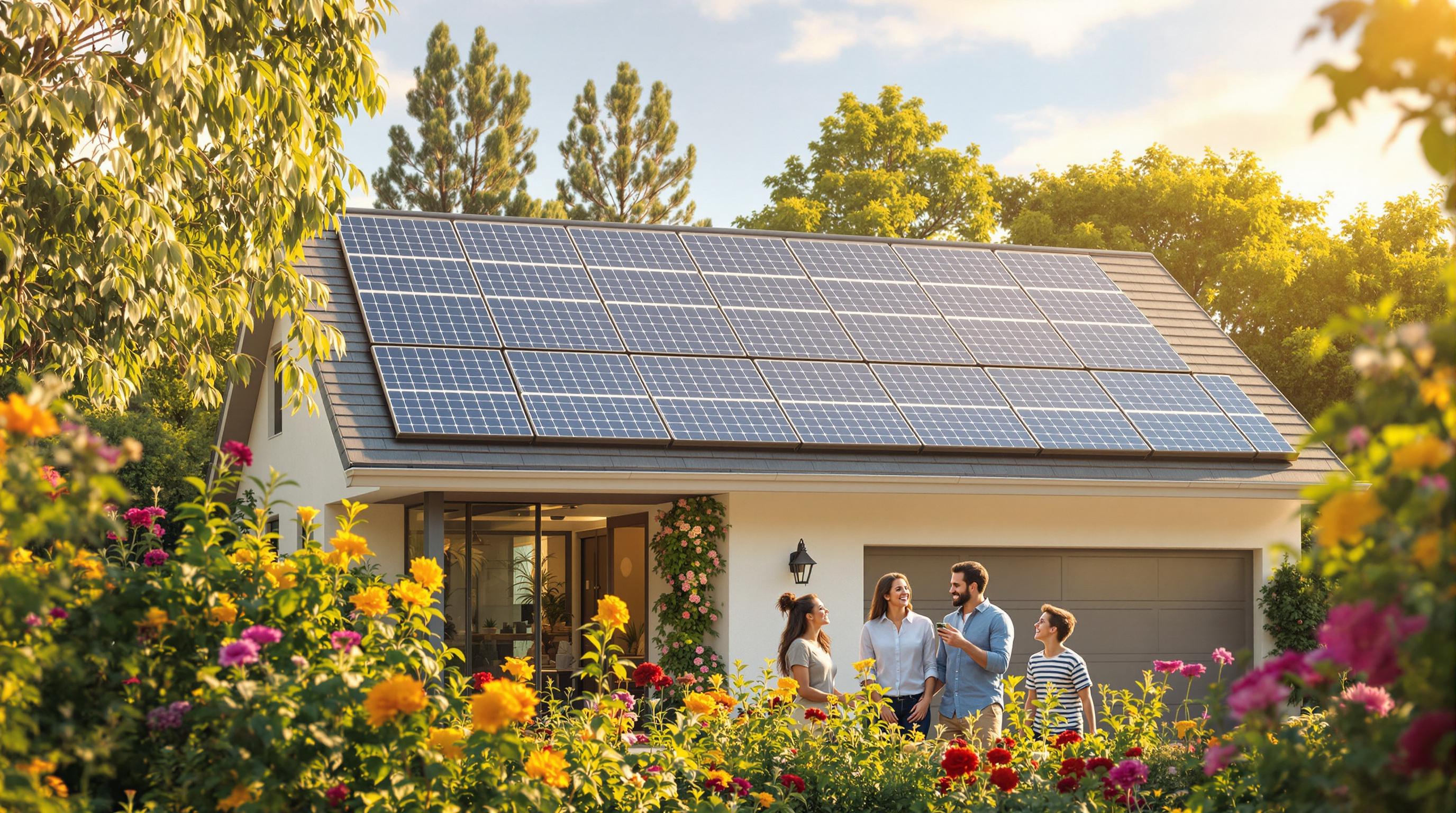Last Updated September 30th, 2025
(TL:DR) The Bottom Line Up Front
If you've been considering solar panels for your home, you have until December 31, 2025, to secure the 30% federal tax credit. The Big Beautiful Bill, signed into law on July 4, 2025, officially ends the residential solar tax credit with no phase-down period. This means homeowners who miss the deadline will pay thousands more for solar installations – or may find solar no longer makes financial sense for their situation.
What's Changing and When
The Hard Deadline: December 31, 2025
Here's is how this law impacts residential solar: The 30% solar tax credit claimed by homeowners (25D) would be terminated at midnight on December 31, 2025. Homeowners who have their systems installed before the end of the year can still claim this credit against their federal tax liability.
Unlike previous solar policy changes that included gradual phase-downs, this is a cliff – the credit drops from 30% to 0% overnight.
What This Means in Real Dollars
For a typical residential solar system costing $28,160 before incentives, the tax credit currently reduces your cost to about $20,000. After December 31, 2025, you'll pay the full amount. That's an $8,448 difference for the average installation.
Lease and PPA Options Remain (For Now)
The 30% solar tax credit for leases and PPAs (48E) would be available through the end of 2027. In a lease or PPA arrangement, the installation company claims this tax credit and passes the savings to the homeowner through lower lease payments or a buy-out agreement.
Why Electricity Prices Will Keep Rising Without Solar Competition
The Perfect Storm of Rising Rates
The average U.S. electric utility rate increased 1.52 cents per kilowatt-hour from January to May 2025–a 9.5% increase in just 5 months. This isn't a temporary spike:
- Data Center Demand: Power-hungry AI data centers are consuming massive amounts of electricity
- Grid Infrastructure: Aging power lines and transformers need expensive replacements
- Natural Gas Prices: The cost of gas used to generate power jumped more than 40% in the first half of this year compared to 2024
- Reduced Renewable Competition: The BBB's restrictions on wind and solar development remove the fastest, cheapest sources of new generation
Depending on where you live, residential electricity rates are projected to rise between 15% and 40% by 2030, according to ICF, and could double by 2050.
Regional Variations Matter
From June 2024 to June 2025, Maine experienced a 26.4% increase, the largest increase in residential electricity prices in the United States. Meanwhile, some states like Nevada saw decreases. Your local market conditions will determine whether solar remains viable without credits.
The Solar Economics Without Tax Credits
Industry Veteran Perspective
A solar business owner with 19 years in the industry offers this perspective on the post-credit market:
"In my market, break even times without the tax credit are still well under 10 years. (Not bad considering that when I started my business, break even times were 15-20 years)."
This dramatic improvement in solar economics over two decades means that in many markets, solar can still make sense purely on energy savings – but the math is much tighter.
The New Calculation
Without the 30% credit, homeowners need to consider:
- Local electricity rates (higher rates = faster payback)
- Available sunlight in your area
- State and local incentives that may still apply
- Home value increases from solar installations
- Protection against future rate increases
Public Reaction: What Homeowners Are Saying
Reddit Community Concerns
The solar community discussion reveals several homeowner perspectives:
- FOMO is Real: "We missed it" sentiment is already building, with many expecting neighbors who don't act will regret it
- Skepticism About Timing: Many question whether installers can handle the rush before December 31, 2025
- Looking for Alternatives: Homeowners are exploring battery storage, energy efficiency upgrades, and time-of-use rate plans
- State-Level Hope: Some expect states to fill the federal gap with their own incentives
The Installer's Warning
NECESolarGuy, a 19-year solar veteran, predicts: "We good installers are largely sold out for the year by pulling in sales from Q1 2026. That means Q1 2026 will be lousy."
Translation: If you wait too long, you may not find a quality installer with availability before the deadline.
Your Action Plan: What to Do Now
If You're Ready to Go Solar
Immediate Actions (Today - Next 30 Days)
- Get multiple quotes from certified installers NOW
- Check installer availability for 2025 installations
- Verify your tax liability can use the full credit
- Lock in pricing and installation dates
Critical Timeline Considerations
- Installation timelines typically run two to four months
- Permit and interconnection can add 30-60 days
- The solar industry expects a significant rush in the second half of 2025
- Starting the process after September 2025 is risky
If You're Still Researching
Key Questions to Answer
- What are your current and projected electricity costs?
- How much unshaded roof space do you have?
- What's your federal tax liability for 2025?
- Are there state/local incentives in your area?
Resources to Consult
- EnergySage or Solar.com for quotes comparison
- Your utility's rate schedules and projections
- State energy office for local incentives
- Tax advisor for credit eligibility
Market Dynamics: Why Waiting Could Cost More
The 2025 Solar Rush
78% of installers predict they will sell more solar in 2025, according to recent industry surveys. This surge in demand will likely cause:
- Higher installation prices due to capacity constraints
- Longer wait times for quality installers
- Potential equipment shortages
- Rushed installations that may compromise quality
Post-2025 Market Predictions
NECESolarGuy shares insights on what happens after the credits expire:
- Q1 2026 Slump: "A lot of buyers will start thinking solar isn't worth it without the tax credit. 'Welp. We missed it.'"
- Electricity Price Reality: "With the growth of demand plus the devastation of the fastest deployable energy source, prices of electricity will skyrocket."
- Market Recovery: "Skyrocketing electricity prices will get people thinking that solar is worth it without the tax credit."
- Quality Improvement: "There should be a reduction of scammers" as only legitimate businesses survive
Alternative Options If You Miss the Deadline
Solar Leases and PPAs (Through 2027)
If you miss the ownership deadline but still want solar:
- Third-party ownership remains eligible through 2027
- Lower upfront costs but less long-term savings
- No maintenance responsibilities
- Immediate electricity bill reduction
Battery Storage Opportunities
Home battery storage would qualify for the 48E tax credit through 2032. This credit will be available for retrofits (adding battery storage to existing solar) and standalone systems.
Energy Efficiency First
If solar doesn't pencil out without credits:
- Insulation and air sealing improvements
- High-efficiency HVAC systems
- Smart thermostats and energy management
- LED lighting upgrades
State-by-State Considerations
States Where Solar Still Makes Sense Without Federal Credits
High Electricity Cost States
- Hawaii (40.96 cents per kWh)
- California (despite recent net metering changes)
- Massachusetts (27.40 cents per kWh)
- Connecticut (30.24 cents per kWh)
Strong State Incentive States
- New York (state tax credits remain)
- Massachusetts (SMART program continues)
- Illinois (Shines program active)
- New Jersey (SREC market still functioning)
States Where Credits Are Critical
Low Electricity Cost States
- Nevada (11.42 cents per kWh)
- North Dakota (11 cents per kWh)
- Utah (low rates, limited state incentives)
- Wyoming (cheap coal power)
Financial Considerations
Making the Most of the Credit
Maximize Your Benefit
- No income limit for claiming the credit
- No upper limit on credit value
- Can carry forward unused credits
- Applies to battery storage installed with solar
Common Mistakes to Avoid
- Not verifying sufficient tax liability
- Choosing the cheapest installer without vetting
- Oversizing system beyond needs
- Ignoring warranty and maintenance terms
Financing in a High-Rate Environment
With interest rates remaining elevated:
- Compare loan rates from multiple lenders
- Consider home equity options
- Evaluate lease vs. ownership carefully
- Factor in electricity inflation protection
The Bigger Picture: Energy Independence
Beyond Financial Returns
Solar adoption isn't just about ROI:
- Protection from grid outages (with battery backup)
- Reduced carbon footprint
- Energy independence from volatile markets
- Increased home value and marketability
Long-Term Perspective
Study after study—including this 2025 analysis by solar.com—has shown that solar panels increase home value. The added value varies by location and other factors, and is not directly impacted by the solar tax credit.
Expert Predictions: The Road Ahead
Industry Transformation
NECESolarGuy's 19 years of experience provides valuable perspective on market cycles:
- Consolidation of installer market expected
- Focus on efficiency will drive costs lower
- Technology improvements continue regardless of policy
- Fundamental economics increasingly favor solar
Consumer Impact
"Skyrocketing electricity prices will get people thinking that solar is worth it without the tax credit," predicts the veteran installer. The question isn't if solar will remain viable, but whether you'll pay 30% less by acting now.
Your Decision Framework
Go Solar Now If:
- You have sufficient tax liability for 2025
- Your electricity rates exceed 15 cents/kWh
- You have good sun exposure
- You plan to stay in your home 5+ years
- You can secure installation before December 2025
Consider Waiting If:
- Your electricity rates are very low (<10 cents/kWh)
- Major roof work is needed first
- You're moving within 3 years
- Strong state incentives are coming
- You have significant shading issues
Conclusion: The Window Is Closing
The elimination of the 30% solar tax credit represents a fundamental shift in residential solar economics. While solar technology continues to improve and costs continue to fall, the immediate loss of nearly $8,500 in savings for the average installation cannot be ignored.
As one industry veteran put it: "We good installers are largely sold out for the year." The message is clear: if you're going to act, act now. The combination of rising electricity rates, installation backlogs, and the hard December 31, 2025 deadline creates a perfect storm of urgency for homeowners considering solar.
The future of residential solar will ultimately depend on fundamental economics rather than subsidies. But for homeowners who can act before the deadline, the question isn't whether to go solar – it's whether you can afford to wait even another month.
Take Action Today
Get Your Free Solar Savings Report - Enter your address to see how much you could save with solar before the tax credit expires.
Find Trusted Local Installers - Our Solar Super Search connects you with certified professionals who can meet the 2025 deadline.
Find Solar Installers Near Me →
Time is running out. Every day you wait is money left on the table.

